London to Cape Town 2012 - Route Survey
Reports from the Route Survey team.....
In January Philip Young and Jim Allen completed a major route in Africa. On this trip they concentrated on the Sudan, Ethiopia and Kenya where the dirt roads make it important the survey is done in the same “weather-window” time of the year as the rally. The drive to Syria, Jordan and Saudi Arabia is being completed later in the year.
Click the link to open a Google map of the route >> Route Map
Route survey photo galleries:- | 1: To the Sudan | 2: In the Sudan | 3: Ethiopia & into Kenya |
From Cape Town, South Africa
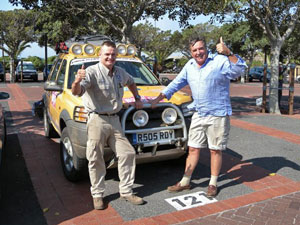
We have arrived in Cape Town! It’s a good feeling, driving between the manicured lawns, sweeping round the roundabouts towards the waterfront, and finally, turning off the engine for the very last time.
Our last Diary Report had us on the northern-edge of the Kalahari Desert, at the dusty little town of Ghanzi. We wanted to explore a 70 kms bush track near here, and then go right across the desert and emerge at Uppington. However, the car was creaking and groaning, so we cut (a very long cut) to Jo’Burg, to the Emgee Workshop of Roger Pearce. As the name implies, Roger is the sort of bloke that if you broke off an arm, it would have octagonal veins running through stamped with the MG letters.
In three hours, he restored the Freelander with a good service, replacing the Honda Civic driveshaft (“not sure how you got here, must have been a miracle”) and with a Land Rover item and new drive-shaft, we were good to go. He also took us to his home, promising to cook us breakfast and the idea of a shower was welcome too… his wife Lorraine was only allowed to brew up a pot of tea, something she did three times as the first hardly touched the sides. Poached egg, crispy bacon, brown bread and marmalade, Roger jumps around the kitchen in his shorts and trainers and 15 minutes later we are looking out over his garden to a most welcome breakfast… the night before had been three hours parked up beside the road trying to catch some sleep in the car while trucks roared past.
Abandoning the route had not been an easy decision. But when back at Livingstone, the last words of Nick Selby at the Foley’s Land Rover garage was “take it gently, it might not last long.” In fact his transplant of Honda item in the drive-train did well.
After leaving Roger’s workshop – stuffed with all sorts, not just MGs, we saw a Daimler Dart, Triumph TR4, Jaguar E-Type V12 with the engine out, and a as-new Hillman Minx convertible, we hit the road for Cape Town.
Another long main road haul might sound rather dull. The weather made sure it was nothing but…a tremendous thunder-storm hit the road some 300 kilometres out of Jo’Burg, and we drove through the eye of the storm, with almost zero visibility. We had seen it coming… thick dark clouds rolled in on the left side, while over on the right, the horizon still had a hole in the sky to show a touch of blue which turned pink as the setting sun made its farewells. Then the storm took over. This slowed our pace right down, tricky going at times, so we stopped for the night… at yet another trucker’s doss-house, and this morning knocked off the remaining 800 kilometres, to drive into Cape Town in time for lunch.
We have found some good roads, others not so good, and a few the rally perhaps ought not to go near. We go home with more work completed than we first planned, but, now need to sort out a return trip later this year to plug the gaps. Equally, we found some great places to stay… and some not so great but probably will prove to be truly memorable, and, we met some marvellous people along the way. We have met with nothing but goodwill and encouragement, wherever we stopped.
Our short stay in Cape Town ended with meeting up with two readers of this diary. Angela Swain, and her friend Lucy, have become sufficiently inspired to have a go themselves. These two South African ladies are planning to drive one of the smallest cars in the event, and we were presented with a completed entry-form for a VW Golf, a car that was made in South Africa until last year. It’s the classic Mk1 shape. We took Angela off for dinner at the Mount Nelson Hotel on the other side of town – it was the Mount Nelson where Eric Jackson finished his record-breaking drive of 14 days behind the wheel of a Ford Cortina. A fitting place therefore to celebrate the end of our own journey.
Angela drove us to the airport, and next week is going up to Jo’Burg to talk to Roger Pearce about preparing her car… look out world, these two girls are really fired up and determined to crack the London to Cape World Cup Rally.
We will be writing a “reflections” newsletter to those on the Cape Town newsletter list in the coming days.
Philip Young
From Ghanzi, Botswana
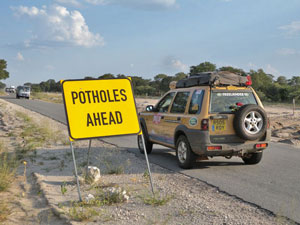
We left Nata and turned directly west for Maun, a considerably better road with recently resurfaced tarmac, and making an early start at 6.30 from North Gate Lodge we drove for three hours with the early morning sun on our backs, arriving just in time for the end of breakfast at Riley’s Hotel. It had been an easy run, with just one police checkpoint, who looked at our International Driving Licence and then waved us on, and without any stops for elephants in the road.
The plan had been to turn south-west towards the Kalahari, and then take in a 70 kms gravel road which looks promising for a Time Trial, which will hook up with some 200 kms of dirt road, an ambitious assault right through the heart of the Kalahari Desert. It will bring us out at Uppington. Jeremy Clarkson and the Top Gear boys came this way, and while the usual antics of driving around with no doors is all a bit predictable, the sunsets and the scenery were truly stunning. But Africa has a way of upsetting the expected, and today’s gameplan just didn’t work out like that.
We are in Ghanzi, where we were due to turn off the main road and onto the first part of the long haul on gravel, but we are now awaiting attention to our front drive shaft, which is sending up some worrying vibrations at anything more than 80 kph. We have found a workshop and will be on their gate at 7.30 in the morning …hopefully, we can tighten things up (or, even weld it up, as Nick Selby had considered when thinking out loud back in Livingstone), and hopefully then get going, but ideally, what we need is a new left-side Freelander drive-shaft with constant velocity joint. We have 1,800kms between here and Cape Town to cover. Is there a reader of this Diary who is in the region and provide the magic-wand??
Looking back, some of our problems might well have been brought on ourselves . Had we had a tyre-compressor on board, we could have lowered and raised the tyre pressures on the haul from the Ethiopia border and across the harsh desert of northern Kenya, where the track is akin to driving on the Moon. We could have dropped the pressures for the first 150 kms of hard corrugations, which shake the fillings in your teeth and rattle your eyeballs. Goodness knows what all this shock does to drive shafts and suspension. We could then have pumped up the tyres for the later rougher bits. As it was, a compromise of 36lbs all round got us to the end of a difficult day without a single puncture, which was pretty impressive given that the Cooper tyres are merely “Reinforced” jobs. But… Perhaps this was the start of problems setting in.
Also, it has to be said, when you buy a car with a past history, you are also buying past metal fatigue. The car has done the longest Camel Trophy of the whole series in romping around South America in 1998, and while Rally Preparation Services in Witney have replaced a lot of the usual “wear and tear” items, where, exactly, do you stop? At what point do say this is an item that is likely to have had a hard time, so let’s replace it, and where do you say “this looks in good condition, let’s leave well alone.” Time, and budgets, also are a key influence in all this. Yet metal fatigue will always find the weakest link. And, as Nick-the-Genius back in the Land Rover garage in Livingstone said, “in Africa, everything busts … sooner or later everything breaks.” We are not going to record what he thinks of Toyotas.
Today we sliced through a rubber hose that acts as an air-intake to the turbocharger, we could hear it wheezing and it was obvious all the vibration had caused it to split. So it was sliced through, and the ends joined up with gaffa tape. It looks very much as if the pipe was original equipment to the car, so, a 1998 Camel Trophy original bit of history here went under the scalpel - an item which finally, in Botswana, said enough is enough. It was gremlin that was sorted in ten minutes in the car park of Riley’s Hotel in Maun. Since leaving Dover, we have had very few Gremlins, so let’s not lose a sense of perspective. I’ll come back to the Freelander when I write our summing up of all this.
Right now, our minds are focused on cracking on… and getting further south than the top of the Kalahari. It was chicken and chips yet again tonight, that in itself is a good incentive not to stay here longer than we have to.
Philip Young
From Nata, Botswana
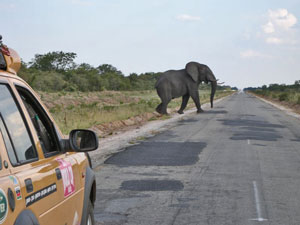
It was only a matter of time. You simply cannot storm down the full length of Africa without a day of either suffering African Gremlins, or, African Wildlife, and today we suffered both.
First, the wildlife. It’s such an uplifting experience when you come across elephants crossing the road, and today we had to stop for four such experiences, and it doesn’t matter how many times you have seen wild elephants on your rally-travels, it’s an experience that always proves uplifting.
And we needed some uplifting. We also had a herd of giant Kudu, as big as the biggest reindeer you’ve seen, also by the roadside, with giant horns and a body as thick and strong as a Fresisan bull. We also saw plenty of monkeys.
But the morning began as a drepressing affair, as first we left the Royal Livingstone and drove into town to sit outside the gate of Foley’s, the local Land Rover specialist. Nick Selby came along bang on 7.30 to open up. Grumpy, moody, and offhand, we didn’t think we would get much out of Nick at first, but after he drove The Camel into his workshop, and got his two lads to work taking the wheel off, the atmosphere changed. It was a challenge… and Nick likes a challenge.
Yesterday, we suspected a broken drive shaft. We were not far wrong. In the rapir to the ball joint, the driveshaft had a circlip either not put back right, or, the circlip decided to part company… first, we had a knocking noise, and then a pull strongly to the right. We inspected the left side, and the right, couldn’t see anything wrong, but drove on slowly, accompanied by gruanching noises that sounded ominious. Nick said the same thing. The drive shaft had come totally detached on the left side, well, we said, it was not like that when we jacked it up. Hmm, it could have done a lot of damage …nobody spoke, the two lads got to work stripping it all out.
Nick’s verdict was that we needed a Land Rover Freelander constant velocity joint, that goes on the end of the drive shaft. A call to the Land Rover dealer back in Lusaka revealed they had the spare, but couldn’t open up till Monday and it would be a day or so before it could arrive, at the earliest, possibly, best part of a week.
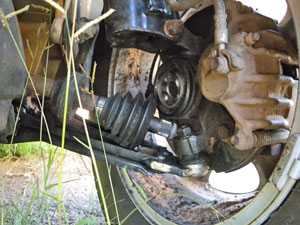
So, Nick said he would drive into town and see what he could come up with. Half an hour later he returned with a Honda Civic drive shaft. Put the two side by side on the workbench, and they look identical. Nick got one lad to give it a bit of a grind with an electric drill, and rummaged for some bottles of Loctite. This super-glue substance is highly rated by Nick – he says if it fails on the way out of town, come back and he will weld it all up.
After three goes, three strip downs, the Honda CV unit fits the Freelander. A minor miracle. By 12.0, the workshop are packing up and we are reversing out of the yard. Without doubt this is a remarkable feat of ingenuity on behalf of Nick Selby and his two lads, who simply refused to be defeated. It really was an act of genius all down to the tenacity, cunning and determination of the Foley Workshop, and Nick Selby… who is also a pretty likeable sort of bloke, who certainly knows his Land Rovers.
We caught the ferry across the Zambezi. By now it was early afternoon. A hectic, manic affair, and once in Botswana, started to pound down 300 kilometres to the first town, along excellent tarmac with long, long straights bordered by all grass, often 10ft tall. Nata is little more than three gas stations, one small hotel, made up of chalets with thatched roofs, totally some 20 beds. But welcome non the less. We were aiming to get to Maun today – this one of the few times where the Route Reconnaissance Team have failed to meet their set target. Basically, we are now 300 kms behind target.
A gin and tonic, followed by a Lion lager, restores things marvellously, and Susan the boss has served up an excellent dinner. Jim had Chicken and Chips. I had the only other thing left on the menu…Chips and Chicken. Followed up with Apple Pie Crumble, and, er, another G&T. It’s an early night as we have a lot to catch up with tomorrow, but after such a fraught day, a good night’s sleep is guaranteed.
Philip Young
From Livingstone - Victoria Falls, Zambia
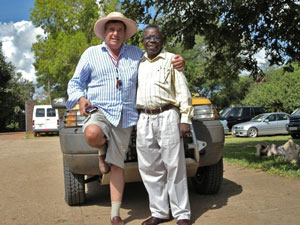
PY and the Zambia Motorsport Association VP
A late start from Lusaka. We went to the Land Rover dealer on the outside of town with Sam Chingambu, (vice president of the Zambia Motorsports Association), found the car had been fixed with two new ball joints and a load of grease pumped into prop-shaft universal-joints which are growling in protest if we go over 100 kph.
Sam kindly led us out of town in his Jap-box which was a great help as we negotiated various roundabouts being cut up by the local taxis (all painted in Ford Olympic Blue), and finally we are on the right road to Livingstone. We stopped to say goodbye and we were on our way.
We took a look at an off-road section but the car was moaning and groaning, and we realised we were just wasting our time given that Sam and his rally-organisers could knock this into shape far better than us with all their local knowledge, so we pressed on - we hope to be back to see Sam and the Zambia International Rally which uses the sugar plantations in this region next May.
The road settles into a quiet and lonely lope, but nearing Livingstone the front drive shaft has given out all sorts of painfull noises and the car is pulling to the right, so, we limped into town, found Foleys, the Land Rover workshop, but they had just closed ....tomorrow morning at 7.30 they open. We plan to be first at the gate. There are similar fixers of Toyotas and Nissans nearby and Bennet's, a large general purpose parts dealer, so this is a sort of "motor city" for Livingstone.
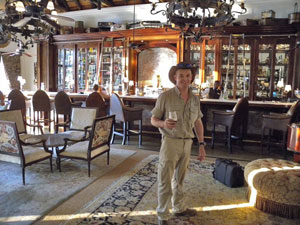
We drove on towards the River Zambezi. We could see the mist of Victoria Falls over the trees, and the sun was falling fast, but priority was nursing the car so we couldn't hurry the last bit. Pulling into the gate, we went wrong - look, all route-surveys are allowed a wrong turning now and again, and we found ourselves heading towards the Royal Livingstone Hotel, not the Zambezi Sun. But we had seen several Zebra on the golf course of the Zambezi Sun, crapping on the manicured lawns and drinking out of the swimming pools, so concurred that we were indeed heading in the right direction.
We have rattled off a few photos of the setting sun, as we drank a gin and tonic (Jim was into an ice-cold Guinness), and you'll get the atmosphere from these ...big beams, straw thatch roof, leather books, leather chairs, long mahogany bar (not quite as good as Hemingways, Kenya, but must rank as second-best), and fan is slowly turning in the ceiling ...the piano is playing Scott Joplin in the corner, missing several essential notes. The barman is mixing cocktails and a chocolate milk-shake all at once, and all around are large black and white photos of the White Man enjoying the Livingstone Hotel around 1910 (there is a car in one shot) ...and suddenly the car problems are forgotten.
Turn the tap and there is instant hot water, a towel-robe is across the bed, and the view out of the big window is of the Zambezi whizzing by over the Falls just a hundred yards up the lawn...
This has been an easy day. That is not to say it will be the same for you, as Sam and his mates have plans to give you a spot of competition you won't forget, and leave you with lasting memories of Zambia far more impressive than flopping about in hotels like this.
Philip Young
From Lusaka, Zambia
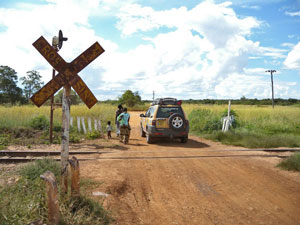
Zambia Hospitality - (Thursday 17th) We are at the Intercontinental Hotel for a whole day as the Zambia Motor Association want to take us to dinner this evening, which is good as there is much to discuss. They said that when the London to Cape Town World Cup Rally makes the newspapers, all hell will break loose as wherever the rally goes, there will be lots of spectators. How many is lots? we ask... "oh, a few hundred thousand, give or take a few."
Here rallying attracts bit interest. The Zambia Motor Association is supported by the Government, and has several key sponsors such as local banks and oil companies. They organise a round of the Africa Rally Championships, close roads down and use local farm land - we are going to visit some sugar plantations tomorrow which they reckon is good twisty rally ground - and we know from past experience with our events that have come to Zambia that they really know how to turn things on.
So, it's a day to grease the car, change the tyres around and catch up with the laundry. Back on the road tomorrow... heading for Livingstone and the Victoria Falls. Can't decide on the hotel choice, the Zambesi Sun is comfortable enough, but its a charmless pile of concrete built for the Cosmos/Thompson holiday sort of trade, with big swimming pools.... there is more charm with an olde-world type hotel out on the river bank, all wooden beams, button-back leather chesterfield chairs under a straw thatch and you look out over the river speeding by to the Falls at a zillion knots, but I seem to remember being bitten to death while supping the Sundowner, and arguments over poor service and missing laundry.... ho hum, decisions,, decisions.
Another Day… Another Country: Into Zambia (Tuesday 15th) - I once had lunch with Princess Anne. I’m sorry if this sounds like name-dropping, (I could also mention I’ve eaten sausage-rolls with her father), but I was reminded of dining out with H.R.H. when walking out the door of the Princess Anne Room of the Mbeya, Mount Livingstone Hotel. Honestly… What would she really have made of this place? I would dearly love to know. Before dining with Her Royal Highness, I had a little briefing on etiquette and table-manners. It seemed a prudent thing to do - just because she loves horses doesn’t mean she has to dine out with one. Unfortunately it wasn’t curry and a one-fork job, so there were all sorts of solid-silver knives, forks and spoons, which have to be picked up in a certain order, and you don’t ask for Colman’s or say pass the Tabasco. Subjects of conversation are also part of the pre-lunch briefing. Next time, there won’t be any topic other than the Mount Livingstone Hotel, Mbeya, southern Tanzania.
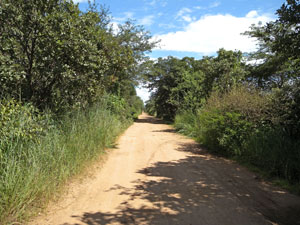
Firstly, the bed was rock hard – sleeping on the floor would have been as good. "Does 'Marm'... which you call her once you have first addressed her as Your Royal Highness, ...have a bit of a back problem from falling off so many horses?" The shower is tiny, and the hand-held shower is a struggle to reach over your head, in fact, I gave up. Jim is almost Princess Anne-height and down the corridor in the “standard room” has exactly the same problem. The chances are that the two rooms are identical, it's just that one now has a red plastic label nailed over the door saying Princess Anne Room after the visit by royalty. All other doors just get a number.
And what would the Royal Patron make of the Spaghetti Carbonara? The dinner menu is a well thumbed worn out grubby plastic laminated wire-bound booklet, as this hotel boasts no less than 100 international dishes, including a whole page of Japanese cuisine, mostly raw fish which must be easy on the kitchen staff when there are power-cuts. The hotel claims no other hotel in the whole of Africa has a menu with 100 dishes. I asked for the Chicken Rogan, but was told it was not available, so bang goes the 100 dishes boast. Next choice: Spaghetti Carbonara, it sounded safe. The Spaghetti was due at 7.30, but by 8.30, and several bottles of Kilimanjaro later, the chef came out of the kitchen, walked to our table, and asked: “Would Sir like some cheese with his Carbonara?” Five minutes later, the plate was put down in front us… it was Spaghetti Bolognaise, with a hard-boiled egg sliced on top as a final flurry of garnish. There was no sign of any cheese.
We left Mbeya after checking an additional hotel, mapping the route to two petrol stations and a tyre depot with a sign over the door – “We Fix Any Make” - and made our way to the border with Zambia. Every other kilometre we noted down a gas station, in fact the run to the border is lined with every sort of fuel station you have never heard of.... “Kobil” is in a type-face and colour scheme that could tie up the lawyers at Mobil for years while increasing their pensions. We later learned the reason for the propensity of gas-stations.... Zambia’s council planners are not at all keen on road-side petrol stations.
Frontier Formalities. You want to know how we got on? Well, it’s a right old shit-fight, as you can imagine.
First of all, you have to squeeze past a line of trucks, then, get forced over by one coming out from the country you are trying to get into, then, the moment you open the door you are besieged with offers of fixers who would sell you their granny given half a chance, “I’m just trying to keep my family off the streets,” was the opening line of one young lad who didn’t look old enough to support a family. But, we know the drill, and no, we don’t need your help, thank you. Pride comes before a fall. In Tanzania, things are pretty slick, and you breeze in and out of various offices, get the carnet stamped… here, and… again, here, and... fill in this form 21a, and... go to that desk, over there… who will tear out the top bit along the dotted line... next.... get your passport stamped, down the corridor over there… Yep! Simples!
Now do it all over again up a muddy yard with large puddles, broken paving slabs, welcome to Zambia. Oh dear! It was us British who taught them all this red-tape, when they called themselves Tanganyika, and now we really are totally tied up in it - just because you know the drill doesn’t mean you can get by without a fixer, (rate of pay to be discussed later).
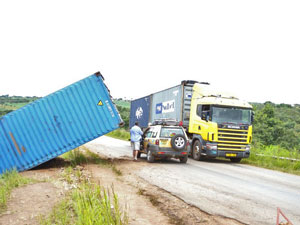
First the carnet is waved high in the air, and over 50 Africans pull back in awe… a foreigner wants to get to the window they are fighting to reach, and, just like Moses, we are now at the head of a line of shouting, pushing, shoving fellow-travellers… all eager to pay something to the bloke on the other side of the window. The carnet is stamped. “Go down the yard, the desk at the end tear off counterfoils,” shouts man behind glass. We shout back. "Why? ...Can’t you tear it off?" “Not our job matey… go down the yard.” So we go down the yard, and then go back up to the crowd to fight to reach the man behind the window again, to get a stamp that proves the counterfoil has been torn off. Smiles! Thank-Yous! See you next year!
Next step: Immigration. We apologise for not having visas, a limp excuse, there just wasn’t time. “You want a visa? 50 Dollars!” Nar, yer having a larf lady… its 30 bucks at Travcour, back in London. “Then go home to London, here it's 50 dollars.” A large label is pasted on another page in the passport, which is thumbed through for another blank page, which is then covered in two large stamps. In five minutes, we have a visa, and some impressive stamps. “Next time, please bring your own ink pad, as this one is drying out… they only really work in our rainy season, when the damp helps the stamper.” We promise to oblige.
Next it’s Customs. This is a worry as we don’t have an easily visible engine number, a must do job that we had overlooked back home. We need not have worried. The bloke behind the desk wants a form filled in, stamped, and handed back to him. He is not going out into the yard to see if the car actually is what it says on the form. The customs man is too busy collecting forms to do any inspecting, and we are not going to make any suggestions, so, we move to the next desk.
What does all this cost? You might well ask. Firstly, we already have insurance, a document called a Yellow Card covers most of Africa, but we are now told we need “local insurance” and have to see a bloke in a blue van parked up outside, who would sell us “local” for $50, then there is the Carbon Tax, another $50, and guess what, the moment the cash landed, the lad behind the desk announced he had to go to the bank. He leaves suggesting we return later for the receipt. Finally? there is a Toll Tax... with so much shouting going on, the exact order of things is now a blur. No, wrong order... we are told we need to pay the Local Council Tax, a mere $30, and, finally, yes, finally, we can’t leave the main gate without paying the Toll Tax. In all, we are now at least 200 dollars lighter, and the fixer’s fee has to be discussed… he gets $50 dollars, and with that, grimaces the sort of look that can only mean his family are about to be evicted onto the streets. He gets his dosh, and now skips off back to his mates to collect his commissions.
To do well and survive in this environment, you need a pair of sharp elbows, a polite manner with lots of smiles, and plenty of “please… today if possible”, while at the same time being very determined and bloody rude. I visit an office with a sign over the door: The Standards Bureau. There I meet a lovely lady who suggests “three hours is the norm here, why didn’t you get yourself an agent?” She sees nothing wrong in the Standards that her Bureau are applying.
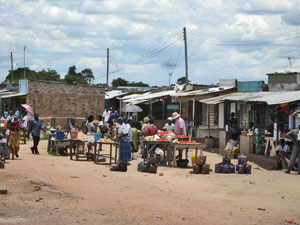
Yes, we were fleeced but the good thing is that we did all this inside an hour, from start of the gate that was goodbye Tanzania, to the Toll Tax man on the last gate saying “welcome to Zambia, er, have you paid the Road Tax?” No, what is that for? “It’s for mending the roads. There are lots of potholes in the next 500 kilometres… we need money to fix ‘em. “
We smile. He smiles. We have all had enough. The Freelander snicks into first gear while we are busy smiling at each other, and gently rocks forwards… the man in the bright day-glo jacket steps back. Jim is holding a fist full of receipts, a complete deck of cards, except for the Carbon Tax Receipt… “to leave this gate, I only look for the Toll Tax, it’s not my job to check all the others….” We laugh, he laughs... and we drive off. Surprisingly, nobody checked if we had a stamp in the passport, or a carnet, all you need to get into Zambia is to pay the man on the last gate his Toll Tax. Down the road, we realise that we didn’t actually need half of what we had just endured… nobody had looked at the car. Nobody checked our bags. Nobody asked what we were carrying, or even where we were going.
If by now you are thinking, “I don’t need all this grief” just consider this: when we crossed this frontier on our Classic Safari Challenge touring event, we breezed through in mere minutes. In fact, it was so pain-free, I can’t recall having been here before!
It was 350 kilometres before we saw the next fuel station, or even a roadside shack selling bottles of coke. We drove down arrow-straight tarmac strips, until we reached the far horizon, then jinxed the wheel a bit, sometimes left sometimes right, but mostly it’s a road that requires no steering at all… all interspersed with the odd vicious pothole. We counted no less than four jack-knifed lorries that had turfed a valuable container of somebody’s goods into the undergrowth.
We drove along completely surrounded by lush green rolling hills of grass, bushes and trees. The scenery, after a night of heavy rain, was remarkably green, and remarkably beautiful. The more we drove, the quieter the road became… 200 kilometres into Zambia, and suddenly we are pounding along with the whole country to ourselves. It’s another world.
Philip Young
From Mbeya, Tanzania
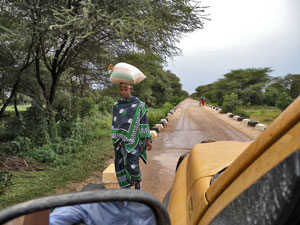
The best of Tanzania… (Monday 14th) The capital city of Tanzania is? ....hands up all those who know the answer. Dodoma is a place nobody has heard of, yet it’s the capital of a vast African country, famous for nothing, with nothing much to shout about, other than the stunning countryside all around, and its remarkable old-Colonial style buildings.
We left “The Modern Hotel” – a truckers cheap doss-house having been woken up at 5.30 to the sound of singing… happy-clappy hymns orchestrated by the Evangelical hotel manager holding an impromptu church service, which echoed all round a hotel, and given all the walls are lined with white tiles, including most of the floors, we couldn’t possibly hope to sleep through the harmonising hotel-staff all rejoicing at the prospect of another day. After a breakfast of two greasy omelettes, we drove around the town for half an hour or so.
While Dodoma might regard itself as a city, in reality it’s just a small town. There are villages back home bigger than this. It has an airstrip, a few roundabouts, and a set of traffic lights. It also has a charming railway station, although it looks as if the last train left town many years ago. The station is in the old-Colonial style, with large sheets of dark red corrugated-iron roofing. Opposite is an old Colonial style hotel that may be our overnight base during the rally.
We were soon on a simply brilliant road heading south. Much better than yesterday. Quite narrow in places – single car width – with many hump-back bridges that need to be taken with care otherwise you end up with a truly heavy landing on the other side – this road is graded-gravel, with soft, chewy, treacle-sort of sand for some long stretches, and blessed with long straights with long open flowing bends, a real drivers delight. We cracked on over this and averaging 75 kph becomes an easy sort of stroll. The road was empty all morning – no oncoming cars, no trucks to overtake.
Two hours later we came across a checkpoint, a security barrier in front of an impressive dam. Five kilometres later you are getting out the car again and signing the book, handing in a green ticket to prove you have passed through (let’s hope they have over a hundred tickets when the rally arrives) and we are on our way again. We found a twisty, gut-wrenching, challenging mountain climb with long drops that requires total concentration, and you find yourself swinging on up through the series of bends on a track that cuts through rich green jungle while hugging the cliff of an escarpment. A remarkable road, and anyone who climbs up to the plateau at the top will be a little out of breath come the summit, after a drive that is truly unforgettable. The mountain-climb is a bit rough in places, dodging large volcanic stones, and rutted and pitted, but the rest of the morning is great stuff.
We took lunch in a scruffy roadside café called “The Yummy” – it was Chicken Biriani… Jim thought it was passable, and tucked in to the mountain of rich yellow rice – but there was more bone than chicken breast and it left me wondering if I should have ordered pizza.
A total of 250 kms of gravel piste is followed by 350 kilometres of welcome tarmac, one of the busiest roads we have driven for a long while, and we spent the last two hours carving our way through trucks – having not seen another driver all morning, the afternoon made up for the loss by being doubly busy, until we found ourselves on the outskirts of Mbeya, honking horns, people walking all over the road, motorbikes, taxis (old 1970s Datsuns and Toyotas), which led us to the Mount Livingstone Hotel. More Old Colonial, the rooms are lined with panels of wood, and your scribe has been given the Princess Anne Room, one of the best rooms in the place, only because the receptionist believed the hotel would be even more famous after receiving a mention in the Rally Recce Blog.
We are now little more than 100kms from the border with Zambia. Tanzania has been good to drive, with super-friendly locals..it surely doesn’t get much better than this.
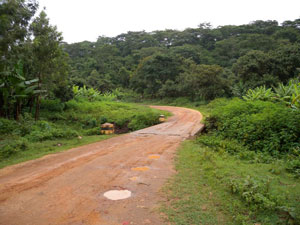
A long day in Tanzania... (Sunday 13th) We set out from Arusha, at the north end of Tanzania, not far from Africa’s highest mountain, Kilimanjaro, and drove directly south to the capital city of Dodoma. On paper, it looks a fairly short day of 450 kms, and is the most direct route – the alternative is a large swing out towards Dar Es Salam, and would add a whole day.
It proved to be an interesting day, the first 200 kilometres on new tarmac, as good as Sudan, and we made excellent progress after a hesitant start getting out of Arusha (Nairobi Road looks obviously the right turning, but with a name like that you think twice before taking it - given we have just come from there), and we are soon pounding our way past vast open grasslands… leaving the Serengeti behind us in the mirror.
We begin to climb steadily into hills ringed with dark clouds – it rained heavily last night and pools of water are in the roadside and some fields appear more like Chinese paddy-fields. Eventually, the tarmac runs out, and we are now on a graded murum dirt road, with potholes filled with water. So far, our journey down the length of Africa has seen us knock off the days without using our windscreen wipers, but we encountered a shower coming into town yesterday evening, and during the night there was a further heavy downpour. We are now driving on mud or slime, with a firm surface underneath.
The road surface varies greatly, but while it is certainly more slippery, and our average speed is brought right down, we complete today without finding anything that will prove impossible in a two-wheel-drive car, so we feel rather pleased. At one point we were overtaken by a Volvo Estate, with a family of at least six on board, with a sofa and a fridge on the roof. It’s been a good day, and run against the clock will be quite a challenge.
The Land Rover Freelander is running totally standard springs and shock-absorbers, and coped with today’s conditions admirably. We dropped the tyre pressures the other day and with less resistance in the sidewalls, collecting a puncture on a sharp stone was a constant worry, but again the 205-80-16s Cooper-Avon A/Ts romped over everything that came our way.
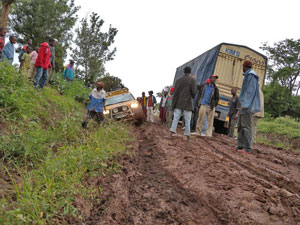
We even took in a spot of hedging and ditching today, as we slid into a deep ditch trying to avoid a truck – we thought we had done all the right things: a) stop totally, get out the car to survey the seen, b) ignore all the shouts from locals giving advice; c) pick a route around; d) holding back the car in first gear, dabbing the brakes… but still gravity takes over, and it decides to slide wickedly sideways – however, it drove out forwards in first gear, but, it cost us 20 dollars. Those who reckoned they had helped push were by now a large crowd, how they all could have got round the back of the Freelander remains a mystery, and we didn’t see one pair of muddy hands. Hindsight is 20-20 vision, and of course what we should have done is paid the driver of the truck to roll back a bit…or, got in the cab and rolled it back ourself…or, brought a smaller car.
We found a mountain climb for a Time-Trial, twisty and steep, and then stopped for lunch. We found a gap between some trees, and drove off the road into the bush. Today’s drive was rather lonely – we drove for some hours without seeing another vehicle on the track, and at times, the bush on either side is encroaching to swallow up what remains of the road, banana leaves brushed either side of the Freelander at one point – single car width. The countryside was magnificent, lush and green and a total contrast for yesterday’s dry and arid bush in the Masai. No two days are ever the same when you drive the length of Africa.
Dining out with Jim is always a surprise, and today the lunch menu consisted of chili con carne, followed up with a frothy cappuccino and hot sticky chocolate pudding. All brewed up on the single ring gas stove. The chili one of Jim’s army-ration boil in the bag jobs. A silver-foil bag is dumped into a can of boiling water and, with the lid back on to pressurise and so speed up the cooking time, the contents of the bag are soon piping hot. The water also cooks a similar bag of chocolate pudding. The hot water then makes the coffee, and what is left over finally rinses out the mugs.
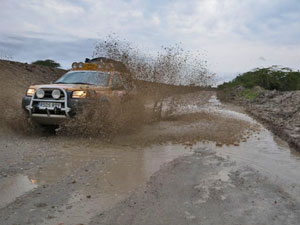
You may at this point be prompted to ask how we are surviving on other fronts – have either of us been ill? We are pleased to report we are in the best of health, and no, Delhi Belly or Montezuma’s Revenge has yet to strike at the Route Reconnaissance Team. This might be down to the fact we have a little bottle of Dettol type substance in a slot in the dashboard, we wipe our hands with this alcohol-primed juice several times a day, and a wet-wipe also goes over the steering wheel, gear-lever and door handles and the like, at regular intervals. Cleanliness is next to Godliness, Grandmother was always saying, and hacking down the length of Africa, we have taken her words very much to heart.
Tanzania is an ex-Colonial country and the locals are quick to remind you that they are members of the British Commonwealth of Nations, and are proud of it – we found someone who spoke English every time we stopped… you are soon surrounded by eager faces wanting to meet you, and excited by the prospect of cheering an international car rally driving through their country.
Tonight, we are just outside of Dodoma, we arrived late, and as it was now getting dark, and we found a truck-stop type doss-house for the night. It looks as if the place could do with buckets of Dettol. The menu promises “Boneless Chicken cooked Italian Style”, followed by vegetable soup. We are too tired to suggest that perhaps the soup ought to come first. However, the fridge has a Windhoek Lager… the first course looks promising, and of the liquid kind.
Philip Young
From Arusha, Tanzania
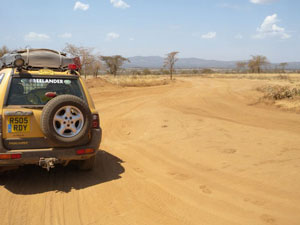
Our last day in Kenya. With some sadness, we inched our way out of the main gate of the Safari Park Hotel, which will be our base-camp after the long flight from Mars (see below).
We drank Tuskers beer in Hemingway’s bar, under its towering vaulted ceiling made of dark cedar logs as thick as telegraph poles, rather reminding us of the real Hemingway’s out on the Indian Ocean coast at Malindi. The car park is massive and we have met up with some former Safari Rally competitors and the hope is that we will run an extensive overnight service-session here - for those who want help with running repairs Kenya is just the place… here they can fix anything.
We left the hotel at 6.20am and being early, and being a Saturday, we rather hoped that it would be a breeze to hack through the city traffic and find the Arusha road south. This proved a little more frustrating than first planned and it was an hour and half before we could relax, and the traffic thinned out.
Our plan was to get to Kajiado, take breakfast in the Gardens Café, and then turn into the Masai bush to explore a maze of roads to the east of the main highway for a Time Trial on classic Safari Rally roads, and we were not disappointed. The hills above the main highway that bores south to the Tanzania frontier look down over some wonderful rallying country, perhaps some of the most interesting and challenging roads we will surely find in the length of Africa.
This was a time consuming process in order to make intricate notes. If we are not inserting the GPS waypoints, writing the Tulip diagrams, adding in some description, we are coping with a variety of terrain that really does offer the lot. We started off on hard gravel, a few kilometres of corrugations, then onto rich red dusty dirt, patches of sand that had to be stormed through. Then deep ruts… some parts of the road here have been washed away totally, over a brow and down a hill…we come across little streams full of boulders (but no water, this still needs marking in the notes, who knows what we will all face this time next year). Then some bigger rivers, thankfully dried up but the river beds are a challenge… if they contained any water at all would be truly awesome.
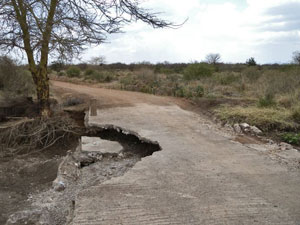
Some bridges look as if they are about to fall down, some bridges have the track washed away, with big lumps of concrete torn away. We found one track only just wide enough for the Freelander, as half the track had disappeared into a wide ditch, running for several kilometres – just as if the ground had been ripped apart by an earth-quake.
However, for those of you bringing a Mercedes 280E, Volvo, Datsun 240Z, Ford Escort, Peugeot 504 or 404, or a Triumph 2.5, you can be reassured that providing you can half drive, none of this will present any problems for a two-wheel drive classic – even a 205… in fact Jim over lunch reckoned the ideal car for this would be either a Citroen 2CV, or a Renault 4.
Talking of lunch, it was yet another Pot Noodle - served up in the middle of the bush, to the weirdest shrieks we have ever heard from birds in the nearby Acacia trees. The cooking pot is a large calor-gas bottle ( ...don’t even think of this, it’s far too heavy....) which burns more fiercely when my ancient ex-Paris Dakar Samonsite briefcase is used as a wind-break. Lunch was washed down with a mug of tea – using up the last packet of long life milk we took from the cafeteria of the Visemar Line ferry from Venice to Alexandria. This milk has been quite remarkable, has travelled well, no punctures in the sachets, and really is long life…we are in admiration for the way it’s still tasting fresh despite the heat, and rigours of the trip.
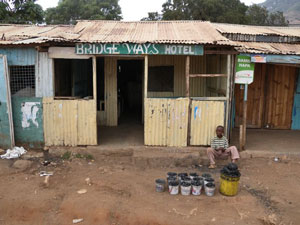
We are now in Arusha. We crossed into Tanzania, border formalities taking little more than an hour, and drove down a brand-new strip of tarmac between vast plains of grass, heading for a pile of dark brooding mountains on the horizon that look as if they are piercing imminent rain clouds, and about to spoil a brilliantly hot sunny day.
We have yet to see any bad weather since leaving France. While in Africa, we have not used the wipers once… but coming into Arusha, sure enough, the clouds from the mountains rolled down and we had a light shower for ten minutes of so, alas, not heavy enough to wash the thick coating of dust from the car, which has got into everywhere and everything. Even the door pockets, tops of the door sills, the dashboard and instruments, are all covered in a fine coating of red dust. Our final few kilometres into town was guided by someone who takes part in rallies with a light-plane – Mike Harries - we had got talking at the border during paperwork formalities, and he turned out to be a mine of information on the conditions ahead.
In the comforts of the hotel – the best in town – a hot shower blasts the dust from ears to toes. Out of the window, we’ve spotted a team of lads down in the car-park armed with buckets about to set to work on the Freelander. So, another country, and another good day, with over 100 kilometres of stunning bush roads under our wheels that now offers one of the best competitive sections so far.
And as the Yellowbrick tracker-map shows, we are still inching steadily south.
Philip Young
From Nairobi, Kenya
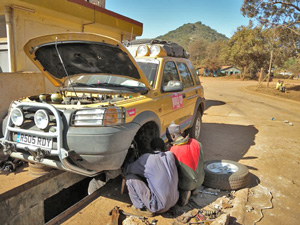
Life on Mars...
A large sign greets us at the entrance to Marsabit saying “Welcome to a little bit of Mars”. Surrounded by rich red dusty roads, and red dusty streets, there could indeed be a drop of the red planet here, and proof, if proof is needed, that there really is plenty of life on Mars.
If you stand at the one and only gas-station, a run down Shell garage, life on Mars is all around you, with honking of horns, music blaring out, noisy motorbikes, the hustle and bustle of this place certainly has plenty of life. Our Freelander is alongside over a pit with two local mechanics giving us a good service.
Up the road at a wooden chalet, Jim is relaxing over a Tusker beer, taking photographs of the elephants, water buffalo and baboons. A few days to chill out then at a place that is virtually the half way point is surely a good moment to take stock of the event, so far.
Firstly, the roads: Conditions have been, in the main, far better than we had expected. However, the 500 kms from Moyale to Marsabit is classic Kenyan dirt track, with sections that are very similar to the piste of Algeria – incredibly rough. Boulders the size of tennis balls hammer into the wheel-arches, cannon into your exhaust, and axle casings, gearbox casings, and the underfloor are bombarded with ancient volcanic rocks.
We were reminded of a conversation we had some time ago with Francis Tuthill, the Safari Porsche specialist at Banbury back home, who reckoned that he had developed a “rock buster” suspension set up for Porsche 911s... here, a rock-buster kit is just what you need, and while most of the African roads we have encountered have been really good, these few kilometres really will be a test of your rally preparation. The World Cup London to Cape Town Rally will be won or lost on reliability, in general, and suspension preparation in particular.
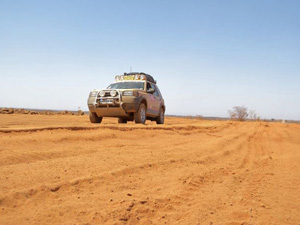
We have seen nothing that would defeat a two wheel drive car, and plenty that will have a 4x4 driver rather bored... there is also plenty where good handling and agility will be a decider (taking a very heavy fuel-tank, heavy wheels and heavy spares could easily overload a car to the point that it is no longer is competitive).
We have seen on the Moyale to Marsabit section stretches of road that really does require as much ground clearance as you can possibly get. So, forget 70 profile tyres if an 80 profile gives you even three millimetres of extra ground clearance, go for the tallest. After all, this is not a rally where going through a corner a hundredth-of-a-second quicker than the next man is going to win anything.
We emerged after a very long day to arrive at Marsabit with no punctures. This surprised the locals, and we met one overlander who had nine, and another who had 14. Our tyres are no stronger than normal van tyres, and had we seen this road would no doubt have opted for something stronger, but the Cooper A/Ts have done well, and the conservative tread pattern ideal for pounding down lots of arrow straight hot asphalt, and are not “diggers” when it comes to skimming over the surface of sand. We ran 36 lbs p.s.i, which might be too hard and the reason why the shockabsorbers are groaning in protest – a difficult balance, as the locals all run softer on the corrugations.
The road from here is smoother (some corrugations, but not as vicious), and about 15 kms of white sandy tracks, which are passable easily in two wheel drive if you keep up momentum and have not got chunky tyres that refuse to skim over the surface), and this lasts for about 80 kms, after that, we are all on brand new tarmac all the way to Nairobi (which is gridlocked with traffic). A time-trial along the first bit suggests itself...
So far, we have met with nothing but enthusiasm from locals everywhere, keen to make the event a success. Everywhere we stop we are surrounded by friendly faces. And we have driven down some of the most stunning roads on earth... most days have been a real driving joy, a reminder of what it was once like to drive without any other traffic. Quite a few days have included hours and hours without seeing another truck or car, which is perhaps the biggest surprise of all.
The Freelander is now in Nairobi. Our next aim is Arusha, on the border of Kenya and Tanzania, after visiting a loop off the highway suggested to us by Yvonne Mehta, a classic section from the glory-days of the Safari Rally.
Philip Young
From Marsabit, Kenya
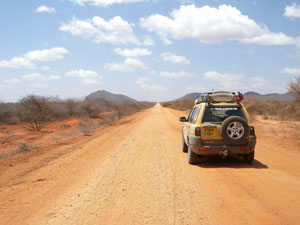
Into Kenya: An early start – it can not be avoided. The hotel owner has also built a new mosque right at the back of the hotel, which starts the chant for customers at 5.30, but as there are so few takers, the morning sermon is also broadcast from the rooftops. If that is not enough, at 6.0am breakfast begins in the cafeteria, we know this as the giant TV screen is tuned in to CNN and the volume is turned up to full-blast.
We leave the car parked outside and take an early morning stroll around the town, with the plastic bags and litter blowing into shop doorways. A smell of bread leads us to a bakers and we buy half a dozen small loaves. Jim the Chef wants to cook an Egyptian tin of frankfurter sausages for our lunch today, and has the Colman’s Mustard to go with it. A trip to a bank, so avoiding all the touts offering to change money, and we then find a cyber café. This is a frustrating ordeal, as the attempt to send pictures back to the Rally News Desk ends in failure, after nearly an hour of fuming. It means we are now setting out later than planned.
We easily find the road south, and after a police checkpoint, another salute and a “welcome to Kenya!” we are on our way. Camels are walking down the side of the track.
The road is fast, smooth gravel, fine dust billows up in our wake as we storm down a long endless track with high thorn bushes on either side. For the first 50 or so kilometres, all is well and we have settled into cruising-mode. Then the corrugations start. If you can imagine 100,000 million scaffold poles placed across the road, a few inches apart, you will get the picture – the drumming, thumping constant kicking through the steering, the shaking of the dashboard that suggests it’s about to land in your lap, even the headlining is vibrating¸ as if to say it’s suddenly decided it wants to try being the carpet. The instruments are a blur. Doors are vibrating, along with everything else. The car is not going to take much more of this, and it seems whatever speed is chosen, the vibration is much the same, but, worryingly, the humps in the road seem to be getting bigger.
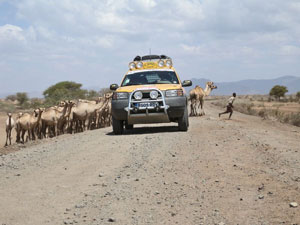
Alarmingly, all this vibration shakes lose a radiator hose and the radiator loses all its water, the temperature gauge climbs off the clock… how long has it been like this? Have we clocked this in the nick of time, or, is the engine now so hot we have blown the head gasket?
We spot a white building on the left, with a large patch of shade beside the left wall, and pull in, and park up. It happens to be a mosque, but this hadn’t occurred to us, with greater worries on our mind. The Imam wants ten dollars, for parking in a holy place, which goes into his back pocket – no hope of a receipt – and water can now be collected in empty bottles found around the back of the car from a nearby tub that collects storm-water from the roof. After 45 minutes of fiddling, the hose is reconnected – all things with screws or nuts and bolts need a blob of Loctite to withstand this kind of pounding, don’t think of leaving home without it… and we are on our way. The road gets rougher, and wilder. We spot gazelles, monkeys, and more camels.
Our day ends at the game-park lodge of Marsabit, after 500 kms of the roughest road we have ever encountered. Elephants are munching on tall grass as we climb up the dirt road to the front of the wooden-chalet hotel. It is just getting dark. It has not been a day without problems and first thing in the morning we are driving back down the hill to the garage where they reckon they can sort what we suspect is broken front shock absorber mountings.
The tyres withstood the pounding today – no punctures from the Cooper-Avon Discovery A/Ts. Everyone says drop the pressures for corrugations, put them up for the serious rough-stuff to keep the sidewalls stiff, but after much debate, agreed to keep them as they are… 36lbs cold.
Kenya has been as radically different from Ethiopia, as Ethiopia was compared with Sudan…the rest of the road to Nairobi simply can’t be as bad as today.
Philip Young
From Moyale, Kenya
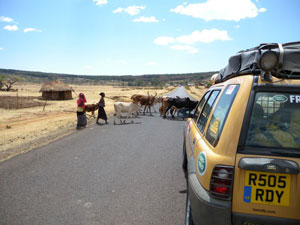
Out of Ethiopia: The day begins at first light, a morning ritual of various checks around the car, and we were soon making our back out to the outskirts of town. It had been one of the most pleasant hotels since leaving The Royal opposite Deal Pier, and just as you say to yourself, “it can’t possibly get any better” your impressions are confounded. Africa is always so full of surprises. We needed a hotel big enough to take the whole rally, and we found it at the Haile, named after the famous Ethiopian long-distance runner who set new world records. This hotel also takes your breath away.
The Haile is set on a bank overlooking a vast fresh-water lake. Enormous glass windows, stretch the full width of the hotel framing a vast panorama of wild Africa. Down below, a couple of fishermen are punting along in reed canoes, it could be Lake Titicaca high in the Andes. We meet the manager and a deal is struck for our booking next January, car parking is discussed and allocated, and various menus also become an agenda-item. This place will go down as one of the highlights of the whole event, and after the ultra-basics of the hostel-like accommodation the night before, a welcome battery-charge for the final day out of Ethiopia.
Before leaving town, we found another tyre-fixer, who disagreed with the previous diagnosis, the flat tyre we had the other day was indeed a puncture, and set to work to prove it, pulling out a horse-shoe nail. Fortunately, one of the last-minute efforts on the preparation front was to get hold of a couple of inner tubes, and the first of these was now being inserted into the tyre which now hangs on the back door – but only after a spot of shopping for a tub of Johnson’s Baby Powder, essential to stop an inner tube chaffing the inner ribs of a tyre and causing yet another puncture.
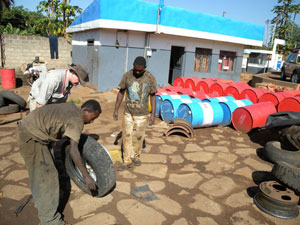
We pounded down empty dead-straight roads that carved long slices through desert / scrub / grasslands, often with weird shaped mounds poking up through the grass – artwork by termites adding some variety to the landscape – and just in case anyone dares to suggest that while this day is a total contrast to the canyons of the Rift Valley is becoming just a trifle monotonous, we have found a competitive section that when measured came out at exactly 100 kms. That should keep drivers and navigators alike on their toes for an hour, or so. For our lunch break, we pulled off the road, parked up under a tree for a spot of shade, and Jim the Chef brewed up a cup of coffee, and with the hot water left over, presented lunch: Yet another Pot-Noodle, this time a “Bombay Bad Boy” washed down with a plastic tub of fruit-salad.
Eventually we end up in Moyale. This is a fly-blown run-down shanty frontier town - overlanders we spoke to said the only thing it’s got going for it is that it’s not the Kenyan side of town, on the other side of the bit of rope that drops down across the road at the end of a long wooden pole. We spotted several “hotels” – we can’t say they are best described as truck-drivers stop-overs, as we have hardly seen a truck all day. Music blares from various shops, there are a few dusty cafes, and walking around in the heat made us realise being pestered by “guides” as young as 12 who either want to show us the way down this one-street town to the frontier, change our money, or show us the best hotel. Jim buys a crate of water. There is then a ruction because the money he handed over didn’t include the cost of the plastic bottles, only the water. Hmm, another scam we didn’t see coming. Given there is no reason to stay here, we rapidly decide we might as well press on, so we found the customs officials and started to jump through the various hoops of form filling. It was now 5.30, and the various desk officials were already packing up for the day, reckoning if we were not done by 6.0pm, we would be spending one more night in Ethiopia. “Which is better by far than the Kenya side of town.”
By the time we emerged from Immigration, behind the high yellow gates and a taxi rank of blue 1980s Toyota Corollas, and crossed the road to the blue gates of Customs, all the offices were closed. We walked around a few, tried a few doors, found one or two that were not locked, and rummaged around a few desks and drawers for anything that looked like a rubber stamp. All we needed was a stamp on the carnet counterfoil to show we had left Ethiopia. We failed to find a rubber stamp, so decided to press on to the next hurdle and enter Kenya without the carnet being stamped, well, why not, it also avoided someone poking around the back of the car, or complaining they can’t find the engine-number.
We pass under a long washing line barrier of old knotted rope, and we are into No Man’s Land. As this is neither Kenya or, Ethiopia, it is not maintained by anyone, and you bounce over terrible ruts for around 500 metres, deep ruts with sharp stones and heavy-landings into potholes that can swallow a Freelander wheel, and we finally emerge at the another pole and long string with a saluting Kenyan soldier. “Welcome to Kenya,” he says with a smile that would make Colgate proud, and we park up under the trees of Immigration. A cool breeze runs down the slope, the sun has been fierce all day is now setting behind us, and it’s another country – it puts a bounce in your step.
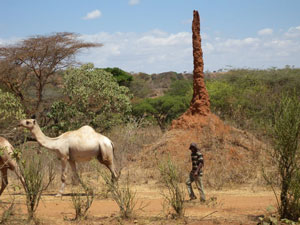
“What time do you close?” The blue-shirted official says 6.30…and looks at his watch. It’s 6.30. We begin with the stamping of passports – a ten minute job and given there are no computers, this is impressive – we reckon the Kenya Customs desk to be the fastest processors of passports so far, and with Immigration waiting, our Carnet is also stamped. The fact the counterfoil to confirm we have indeed left Ethiopia has not been torn out, and also a stamp on the remaining counter foil that proves we have entered, and, departed, Ethiopia, is studied hard by the Kenyan Customs Chief. “I think I know what has happed here.” Hmmm. “But, nothing to do with me - welcome to Kenya!”
With that, we are now driving up the tree-lined avenue. It’s 7.0pm, and, get this, all that we meet in these various offices reckons that entering Kenya will be just as fast when the rally arrives. The trimmed trees, manicured patches of grass, and not a spot of litter anywhere, the offices of Kenya’s customs and immigration services give a totally false impression of what is to come. Climb up the hill and the tarmac stops, and you are immediately in a scruffy town with plastic bags and litter blowing around in the dust of rutted, bumpy dirt-surfaced streets, and all so bad it could make an Afghanistan town look appealing… turn a corner, and it’s now a scene from a Clint Eastwood Western. A frontier town where everyone keeps moving on, not wanting to care much for... whatever direction you are facing, you’re surely just movin’ on…
We found a narrow dirt street with a new hotel, the tallest building in town, we had high hopes of this place, but having found the alcohol-free-bar and dined out on chewy lumps that were described as deep fried chicken, with a cup full of piping hot rice which we watched steaming in a microwave on a shelf alongside the breakfast tea-cups, washed down with a glass of mango juice and four Sprites. It is obvious to all but the management what lost potential there is here. Entertainment while we picked our way around the plates was a giant screen of news reports from ‘Cairo in Crisis’ brought to us by the London office of Al Jazeera.... a ticker tape strap-line at the foot of the screen says their Cairo offices have been shut down – er, get this, by Arabs who suddenly cancelled its funding. We ask the waiter if there is an internet-café in town, but the shrug of the shoulders says it all.
Dark unlit streets outside are none too inviting, so we decide on tracking down someone with internet connections after breakfast… we had hoped to make an early start in the direction of Nairobi, but we are keen to send some photos back to Base-Camp.
The next section, everyone says, will be the hardest yet. A 600 kms trek across a bleak desert will be very hot work, and the first half is all corrugations. A big test for the soft-sprung supple suspension of the old Freelander.
Philip Young
From Awasa, Ethiopia
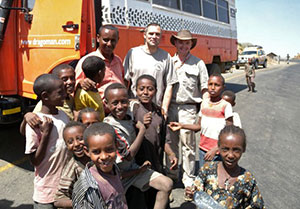
Find more pictures in the galleries
Into Ethiopia: We left Sudan behind us, headed into the rising sun, and pounded down a tarmac strip to the frontier between vast grassy plains dotted with the occasional Accacia trees… it could be Kenya. The border hassles lived up to expectations but we were through both Sudan Exit and Ethiopia Entry in a few hours, and immediately found ourselves driving an excellent tarmac road that twisted and turned along the side of giant canyons of rich red stone. Rounding a corner Jim Allen rubbed his eyes with disbelief… a UK registered truck from the Dragoman overlander-tour company, and being driven by Peking Paris marshal Tony Jones! We stopped for a roadside “Dr. Livingstone, I presume” sort of moment, and from nowhere a big bunch of children suddenly thought this really is an exciting moment and soon drowned out all conversation.
A long day, with one of the most stunning driving roads in the whole of Africa, and finally ending up in the bustling town of Gondar. Corrugated iron roofs of wooden shacks glinting in the setting sun, the roads lined with Eucalyptus trees took us to the top of the town.
The rally hotel was full with various tour groups, so we found a small square a couple of kilometres lower down the mountain – a shabby old villa that was once the bolthole of Italian wartime leader Mussolini. PY asked if he could have Mussolini’s bedroom, but was told it was already occupied – by a German couple. We spent the evening dining with the two Germans,(who stress they are not Facists…) and who agreed with our view that the menu left a lot to be desired, Jim Allen who until now had consistently proved that he could eat anything had a tough time with a tough steak. This steak was called a “Steak Bismarck”, asking how it gets this name we were told it’s as tough as a battleship. Jim can confirm this. It’s decks were covered in two fried eggs, which were eaten, the rest was shovelled to one side of the plate. For Jim, it was a total surprise, not being very adventurous when it comes to navigating a menu, he had ordered Fish&Chips…
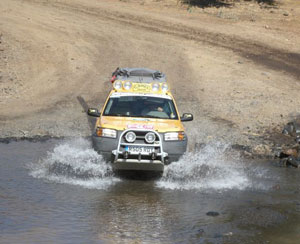
We left Gondar at first light, and aimed the Freelander at Addis Ababa, the goal being to peel off in a busy town some 100 kms down the road, and work our way around the town-centre and find a dirt track, which if the Michelin map is correct, runs for some 200 kilometres and actually “cuts off the corner” saving 100 kms of main road to Addis. We had a frustrating time trying to find the right slot, but once on the dirt, what promises to be an excellent timed-section started to quickly come together. We even found a small mountain stream that had to be splashed through as the bridge had collapsed. We drove between fields and ended up on a sweeping gravel track that rose up and down through rolling countryside. An excellent rally road.
Having started off on corrugations of the teeth-chattering variety (we were so glad the Land Rover retained the standard soft-spring suspension, it copes superbly with ruts and corrugations), the track finally improves, and we were quietly pleased with the way it came together. However, after hitting some bad potholes on the main road as we descended into a spur of the Rift Valley, and one or two bad gulleys on the steep climb on the other side (with many hairpins – this is slow going), it became apparent that getting to Addis in a single day is not really on, so we stopped in a run-down shanty-town of old shacks, and found a couple of beds in a truckers-rest stop. Evening meal was a slice of omelette between two round bread buns.
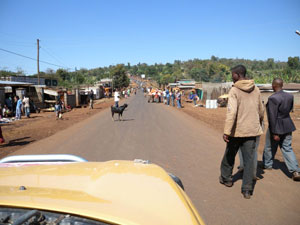
The following morning, we made an early start, after changing a wheel which rather mysteriously had gone flat over night – (taking it to one of the many roadside tyre repair sheds that can be found in every village confirmed that there was no puncture) – we pressed on and found two possible hotels just capable of accommodating the rally.
In Addis, the streets were gridlocked with traffic, we stopped for a mid-morning coffee having discovered an excellent roadside café, which is included in the route-notes. We had another pair of omelettes, washed down with two cups of excellent cups of tea, two glasses of mango juice, and rounded off with a slice of pastry cooked that morning and still warm.
It took nearly two hours before the dodging of trucks, vans and old taxis – mostly Ladas, old Datsuns and Toyota Corollas and India-style two-stroke Tuk-Tuks – and headed south. Not a great day, rally-wise, but we always knew that hacking our way through Addis would be quite an ordeal.
We are now in a pleasant looking small town called Awasa, and found a hotel with only two rooms available (or so the lady says…), we said an immediate yes. It’s been too hot, too tiring to haggle. We have round beds – yep, round beds – a bathroom with a giant round Jacuzzi, television, mini-bar stuffed with various beers, electricity that comes and goes (power cuts are something you get used to, it’s handy to pack a candle and a box of matches), and, given we had no shower available at the truck-stop last night, running hot water. After sending this to the website manager, we are off shortly to the dining room. If there is a Bismarck Steak on the menu, Jim says he is going to be saying yes… as he’s bound to be finally served his Fish and Chips.
Philip Young
From Gedaref, Sudan
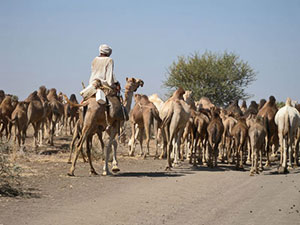
Find more pictures in the galleries
It has taken five days to get across Sudan and hit the road that the rally cars will use running south from the Red Sea coast at Port Sudan on the way to Ethiopia. Sudan is the largest country in Africa but you don’t appreciate just how big it all is until you come to drive it. An 800 kilometre day might sound excessive, but the roads are very empty, and in a very good state of repair - probably some of the best roads in Africa.
After our first camping night on the way south from Wadi Halfa we spent a couple of nights in Khartoum with time to catch up on the laundry and arrange essential meetings. Before getting back on the road we drank a refreshing sundowner of chilled yoghurt and mint while watching the sun set over the Nile. We were sitting on the deck of the ancient gunboat used by Lord Kitchener to re-take Sudan for the British in 1895 from the Dervish who had ruled for 15 years after defeating General Gordon.
Two days from Khartoum and we were exploring an off-road section in the desert neat Kassala. A local camel-farmer was driving over 50 camels to market but as we had lots of notes to jot down we were in no great hurry. Much of the morning was spent exploring tracks that looked promising but ended up nowhere, or, in a village. A wrong turning even had us driving up an old railway line across the desert – no trains were due, it fell into disuse after the British stopped running things in 1956.
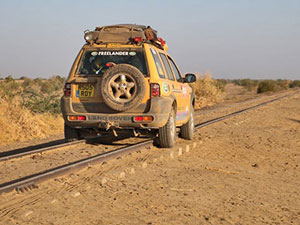
We stopped off in a village and chatted to a tyre-fixer who runs a veteran 70-year-old donkey-engine to power his generator and equipment. He is looking forward to a spot of business from passing rally cars so we noted the spot in the route-book.
The time we have spent in Sudan has been fascinating. We have met lots of interesting people, who are full of enthusiasm for the World Cup Rally visiting their country – it has been pointed out that Sudan has never before received an international rally.
We have seen just four British cars, in our five days here, apart from the occasional 40-year-old Land Rover…a Mk1 Ford Cortina, a Mk2 Ford Cortina with a broken steering arm, and two Hillman Hunters, one parked in a bush and the other in a backstreet. Both Hunters are complete and on the rally route should anyone think of needing spares…
The roads throughout Sudan have proved the biggest surprise, and are far better than we had expected. Petrol is plentiful with gas stations 200 kms apart or less, and there is more readily available supply of diesel than we found in Egypt. All garages seem to stock both diesel and petrol, but often only two pumps – the petrol is universally one grade that we are told is 90 octane. The cars on the road seem modern than in Egypt, mostly Kia, Toyota trucks and Corollas, some Suzuki Jimny’s and Nissans.
It’s the hottest so far, and it’s getting to both of us a bit. Put the washing out on a fence rail and its bone dry within five minutes. The mountains of Ethiopia will be very welcome…
Philip YoungFrom Wadi Halfa, Sudan
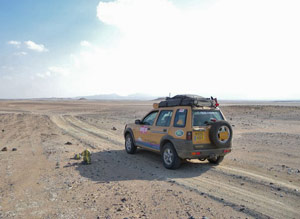
Find more pictures in the gallery
The Route Reconnaissance Team set out from England, stopped the night at The Royal Hotel in Deal where Nelson once regularly stayed, and moved on the following day into Northern France to check out the French Time Time Trial near St. Quentin in the Somme Region, which was tricky as the tracks we hope to use were under water.
We then drove across Europe from Beaune via Chambery through the Alpes into Italy to catch a brand new and very comfortable ferry from Venice to Alexandria, certainly the best ferry we have ever sailed on. Apart from trucks, we were one of five overlander vehicles on the boat so we had the cafe, restaurant and cabins much to ourselves. Brand new... but it sails empty!
The team have now arrived in Sudan. Despite opinions that there would be civil unrest following the recent referendum to divide into two parts Africa’s biggest country, everything is friendly and peaceful, and we have met nothing but co-operation and willing assistance, there is lots of enthusiasm here with locals eager to be part of an international event.
As you know, the route survey has two options on getting to Sudan (one via Saudi, which comes later), this option is via Egypt. We found three competitive sections, to be run as Time Trials, in the desert east of the Nile near the Red Sea, and without doubt these have been the most stunningly beautiful desert tracks we have ever experienced. Something for everyone here, mostly smooth and certainly well within the capabilities of a small two wheel drive car, in fact we have yet to find anything that will be a real challenge for a 4x4, as the desert tracks are often twisty. Rapid changes of direction and navigation with quick GPS work will be called for here if a good result is to be achieved. A few rough waddis (river crossings, which were dry but boulder-strewn) but mostly smooth, very little in the way of corrugations, some sand sections but mostly stones/loose gravel and from the recent tracks we could see, popular with local off-road bikers. One Time Trial was over virgin terrain with no tracks of any previous traveller in site and a storming section to a far horizon with jagged mountains to aim at, the sort of thing only found in a Lara Croft film or a good African adventure such as King Solomon’s Mines. In fact one of the Time Trials is a route used to an old gold-mine.
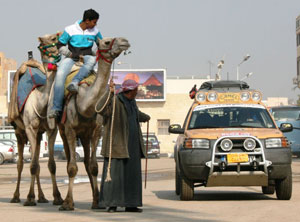
So far, the standard 60 litre tank has been perfectly adequate range, as our car has standard springs and only uprated shockabsorbers to cope with fairly light luggage and equipment we have not filled a jerry-can. Petrol is 90-octane at its worst, some better fuel is available but harder to find. We have a two litre diesel engine and not all gas-stations stock diesel.
Some of the days will be long, we drove one day of over 700 km, and as we have said all along, this will be very much of a “press-on-regardless” style of event, with a pressure that comes from a time-schedule to keep to, with the addition of the Time Trials.
Our recce-photos show the wild, empty terrain of the Time Trials as well as the hectic street scenes, where local children are keen to carry out an enterprising car-wash business the moment you park up. The streets of Egypt are full of Peugeot 504s, some 404s, old Toyotas, and 1970s Fiats – the 504 is by far the most common sight, and all the taxis are 504 Estates. Once into Sudan, it is again the 504 that is clearly the mule of Africa, but there were a row of Series 3 Land Rovers outside the Customs-shed.
We have put into the route notes places where tyres can be repaired or new tyres bought, and local roadside repair-workshops. We expect good back up to the event from locals here. Rallying without sweeper-mechanics is not as daunting as it sounds, there are good facilities to be found in every village. English, Italian and French are common languages.
Sudan has a network of very good tarmac roads. The weather has been warm throughout, and is it hot here, like a really good summer’s day in the UK. No rain is expected, it would seem January is a good weather-window. It is, however, Africa’s biggest country and some very long sections are inevitable before we reach Ethiopia.
For those who are concerned about newspaper headlines and talk of “troubles” we have seen nothing on our travels and met with nothing but friendly enthusiasm. The 1998 Land Rover Freelander might be slow but so far it’s not missed a beat, and there is not a creak or a rattle anywhere.

